March 2025


Principal Consultant

Reviewed By
The global nucleic acid isolation and purification market size was estimated at USD 6.1 billion in 2023 and is projected to grow to USD 16.65 billion by 2034, rising at a compound annual growth rate (CAGR) of 9.56% from 2024 to 2034. Using DNA sequencing in clinical diagnosis is driving the market’s growth.
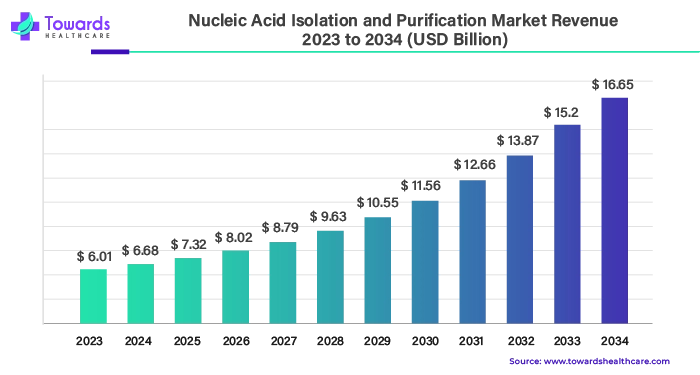
Molecular biology's fundamental technique involves the extraction of DNA, RNA, and protein. These biomolecules can be extracted from any type of biological material and used for preparative, analytical, or downstream operations. Pure biomolecules may now be extracted using a wide range of specialized techniques, including procedures based on columns and solutions. The need for automated systems made for medium-to-large laboratories has increased recently. The purity and quality of the extracted nucleic acid directly impact the outcomes of any subsequent scientific investigation.
Because of their versatility, molecular recognition ability, simplicity of synthesis, and chemical manipulation, nucleic acids are becoming increasingly potent and useful biomaterials. Numerous nucleic acid varieties have been employed as therapeutic agents or as instruments for regulating genes in treating human hereditary illnesses. Moreover, sensing systems for detecting ions, tiny molecules, proteins, and organisms may be created using nucleic acids.
Research on genetic engineering and gene treatment can greatly benefit from AI. Artificial Intelligence is useful for formulating novel theories and supporting experimental methods. Gene-related illnesses and heredity can be identified using prior data from a gene model. Advances in AI present a great chance for logical drug discovery and design, which will ultimately affect mankind. Artificial Intelligence and machine learning (ML) technologies are critical to drug research and discovery. This trend is predicted to affect almost every area of the human experience, and genetics is no exception. This includes machine learning and artificial intelligence.
| Company Name | New England Biolabs (NEB) |
| Headquarters | Massachusetts, U.S., North America |
| Recent Development | In April 2024, the launch of their Monarch Mag Viral DNA/RNA Extraction Kit was announced by New England Biolabs (NEB®). This extraction kit enables extremely sensitive detection by improving the recovery of minute quantities of viral nucleic acid. Viral RNA and DNA are extracted reliably and effectively using the kit's magnetic bead-based method, allowing for scale-up for high-throughput automation. After an enrichment step, the kit works with saliva, respiratory swab samples, and wastewater samples, which are the most popular sample types used to extract viral nucleic acids. |
| Company Name | Alpha Laboratories |
| Headquarters | Eastleigh, United Kingdom, Europe |
| Recent Development | In January 2024, the advent of SmartLidTM, a ground-breaking magnetic key and lid system that simplifies the nucleic acid extraction process, was announced by Alpha Laboratories through an exclusive new relationship with ProtonDx. The innovative approach offers a more intelligent method for handling nucleic acids in applications of molecular biology. It is made for quick and effective viral DNA/RNA extraction and streamlines the three critical sample extraction phases (lysis, wash, and elution). With its cutting-edge capabilities, SmartLid breaks new ground in the industry and provides scientists and researchers with a more intelligent, practical, and environmentally friendly nucleic acid extraction solution. |
The technology for next-generation sequencing (NGS) of DNA or RNA has advanced significantly in the last several years. Thanks to next-generation sequencing (NGS) technology, genomes or portions of genomes may be sequenced quickly—days or hours—at a cheap cost and with high depth. The sequence variants/mutations found by NGS have been extensively utilized for prognosis, treatment selection, and patient follow-up in addition to illness diagnosis. Its massively parallel sequencing capabilities open up new possibilities for customized precision medicine.
For instance,
Regarding nucleic acid purification and separation, automated and kit-based methods are more expensive than conventional methods. Numerous benefits come with automated equipment, including easier isolation procedures, shorter working hours, and higher throughput. However, many people cannot use these devices due to their expensive cost.
Laborious laboratory duties are transferred from humans to robots through automation. While screening evidence is a one-time event, DNA analysis is a recurring procedure that may be automated. The scientist may utilize more samples, examine more plates, and take long breaks from the procedure thanks to the robotic system. A laboratory has to be ready to devote a significant amount of time to validating and training analysts to transition from manual to robotic analysis to reduce backlog and boost output. Even though laboratories must check small and large samples, automation is the only way to accomplish this.
By product, the kits & reagents segment held the largest nucleic acid isolation and purification market share in 2023. A variety of kits and reagents are available in the market for the isolation and purification of nucleic acids. Kits are optimized for use in different circumstances, on different cells, to follow different procedures. Various reagents are used in each step of isolation and purification. Each reagent has a different and significant role.
For instance,
By type, the DNA isolation and purification segment dominated the nucleic acid isolation and purification market in 2023. The isolated and purified DNA is used in various applications. In the genetic fingerprinting procedure, extracted DNA is used to compare an individual's genetic material with a database of genetic material. Determining a child's paternity can be aided by DNA extraction. Official diagnosis of medical disorders requires DNA extraction, particularly in cases of inherited illnesses. Plant and animal genetic engineering can benefit from the retrieved DNA. Vaccines, which are required to manage and halt the illness, are made using DNA. Additionally, DNA is required for gene treatments.
By application, the diagnostic segment held the largest nucleic acid isolation and purification market share in 2023. The blueprints that organize an organism's biological functions are called nucleic acids. In the last century, advances in nucleic acid research and comprehension have opened the door for nucleic acid-based diagnostics. Clinical laboratories and diagnostics have concentrated on the quick identification, prognosis, and detection of a range of disorders by nucleic acid testing, which involves extracting DNA or RNA and then amplifying and detecting the nucleic acid.
For instance,
By method, the magnetic beads segment dominated the nucleic acid isolation and purification market in 2023. Nucleic acids and other biomolecules may be directly isolated from crude samples and a range of sample types with magnetic beads, requiring no processing. This is one of the main benefits of employing magnetic beads. This distinguishes magnetic beads from alternative nucleic acid separation techniques, which may need more hands-on time and/or different processes for various sample types.
For instance,
In 2023, hospitals and diagnostic centers held the dominant share of the nucleic acid isolation and purification market by end-use. Nucleic acids are used in various diagnostic procedures. The diagnosis can be related to genetic testing, disease diagnosis, forensic diagnosis, and so on. All these procedures take place in hospitals and diagnostics centers. Hence, these places play a crucial role in the growth and development of the market.
For instance,
By end-use, the pharmaceutical & biotechnology companies segment is expected to grow at the fastest rate in the nucleic acid isolation and purification market during the forecast period. Pharmaceutical companies majorly use nucleic acids in the development of new drugs and therapeutics. Biotechnology uses it for various purposes, including NGS, studying different genetic materials, developing GMOs, developing genetically modified products, cloning, disease diagnosis, and so on.
For instance,
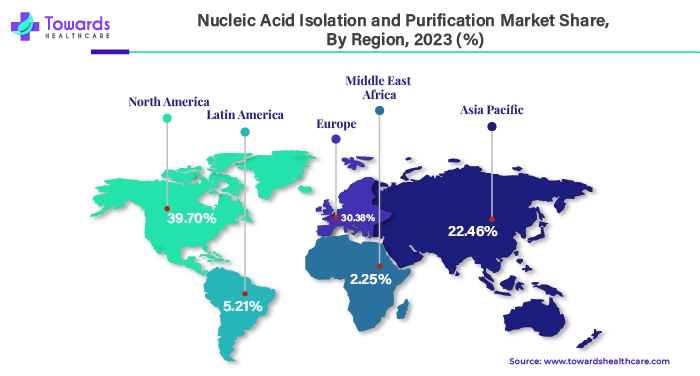
North America dominated the nucleic acid isolation and purification market share by 39.70% in 2023. and Canada, compared to other regional markets, is expected to account for a larger revenue share. Rising urbanization and significant market players offering nucleic acid purification and separation solutions may be blamed for the industry's growth in this sector. Furthermore, as part of their inspection of processed food products in the U.S., the Food and Drug Administration (FDA) and the Food Safety and Inspection Service (FSIS), which are major contributors to the revenue growth of the market, specify DNA isolation protocols for every category of food item.
The Department of Energy (DOE) in the U.S. shared the goal of using biotechnology and biomanufacturing to enhance American lives in 2022. The Office of Science at DOE announced new grants totaling around $178 million to support biotechnology and biomanufacturing research projects. The DOE's EERE also increased its efforts, amounting to $120 million, to help biotechnology and biomanufacturing scale up to a point where biorefineries may be commercialized.
Due to domestic and international investment in the life sciences sector, the Canadian biotech industry has experienced significant growth since 2019. This increase indicates investors' trust in the biotech industry's worth. Over 175 Canadian firms have received investments totaling $25.9 billion. Recent investments in Canadian life science companies include Bellus, Inversago Pharma, and Chinook Therapeutics. The total number of acquisitions has decreased globally, while the Canadian biotech industry has registered $12 billion in 65 investment deals in 2023.
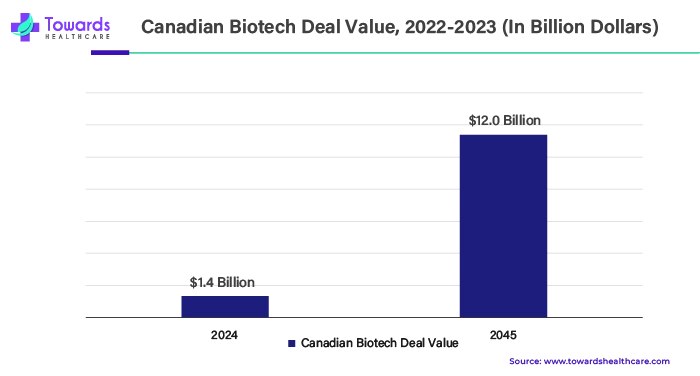
In 2023, the nucleic acid isolation and purification market saw substantial revenue generation across different regions. North America led the market with $2.42 billion in revenue, showcasing its strong demand and market presence. Europe followed closely, contributing $1.86 billion to the global revenue, reflecting its significant role in the sector. Asia Pacific also made a notable impact, generating $1.37 billion, highlighting its growing importance in the market.
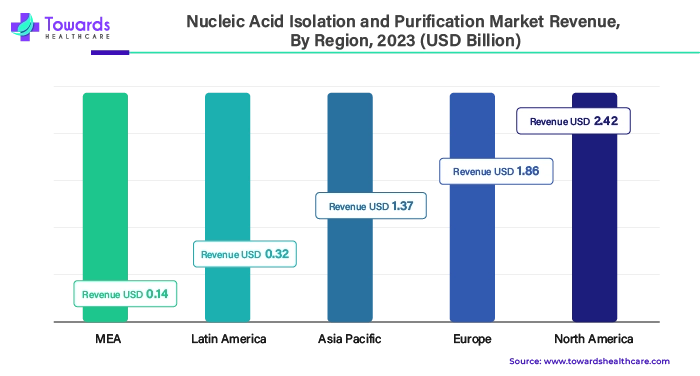
By region, Asia Pacific is expected to grow at the fastest rate during the forecast period. Countries like China and India are highly promoting the growth of the nucleic acid isolation and purification market via biotechnological advancements.
Domestic biotech innovation has been prioritized in recent programs of the Chinese government. A new national strategy has greatly aided the sector's expansion. Biotech PCT patents granted to Chinese companies rose from 266 to 1,920 between 2013 and 2023—a more than 720 percent rise. Companies like BeiGene are highly investing in R&D, which is promoting the market’s growth in China.
For instance,
Through various channels, India is also assisting in expanding the nucleic acid isolation and purification market. The expansion of the biotechnology sector is one of the main contributors. Plasmid DNA and viral vectors are widely used in biotechnology for research and development, product development, illness research, and other purposes.
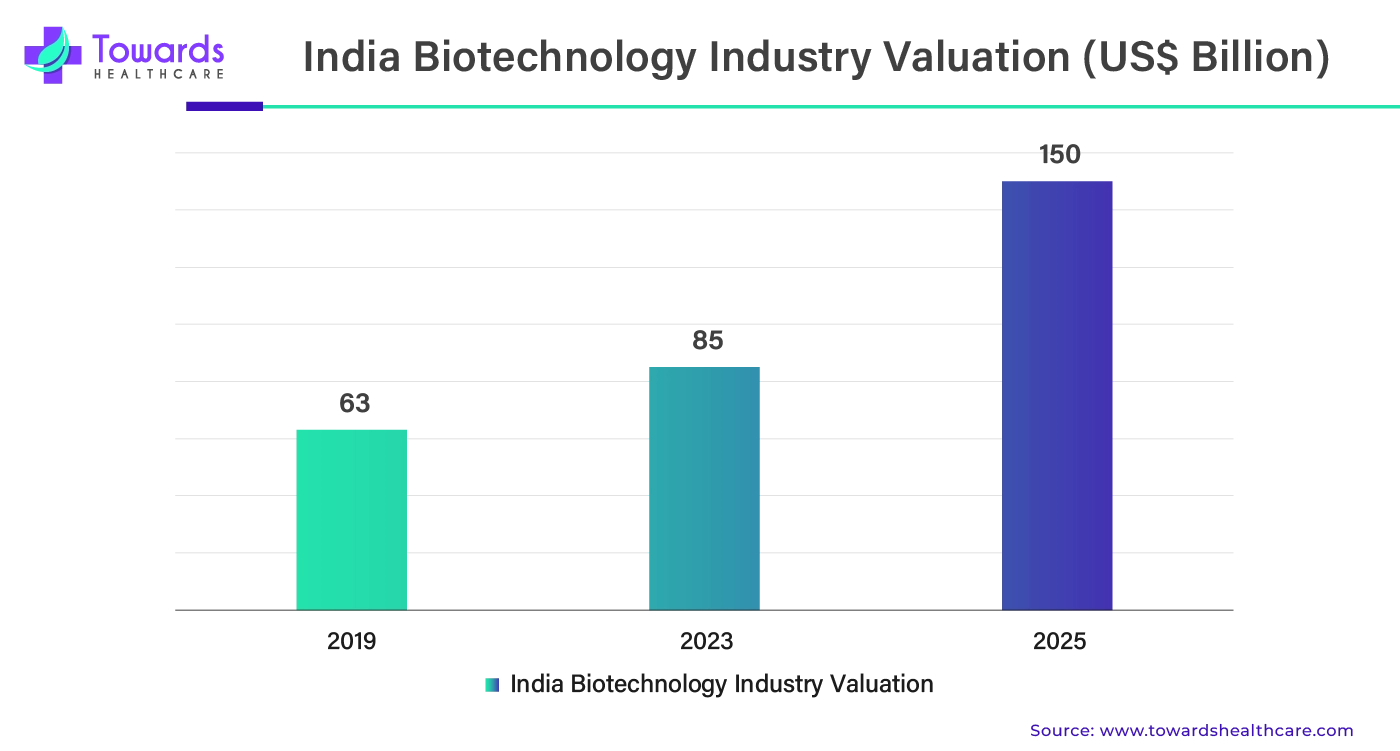
By Product
By Type
By Application
By Method
By End-use
By Region
March 2025
March 2025
March 2025
March 2025